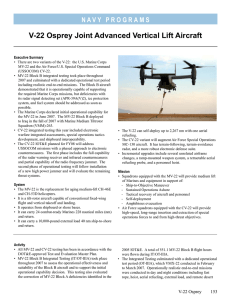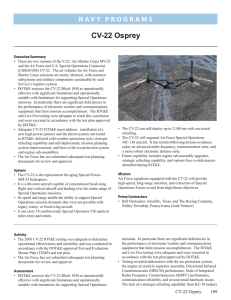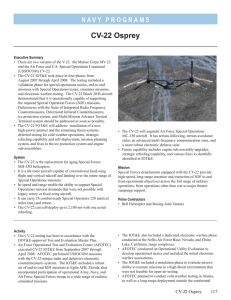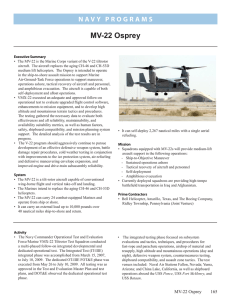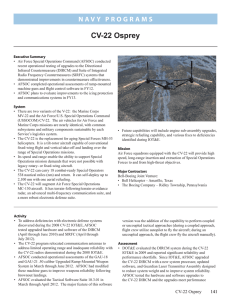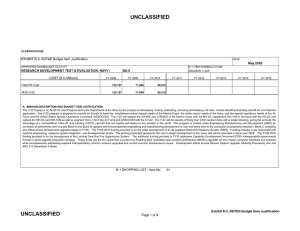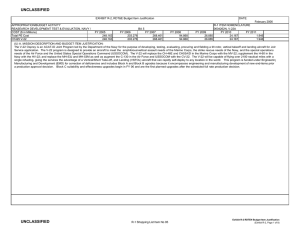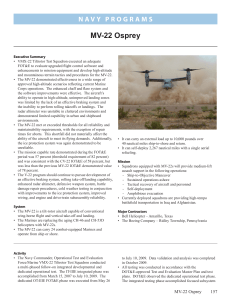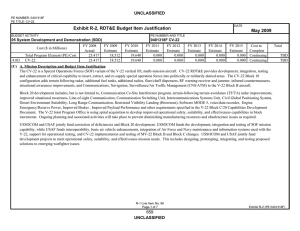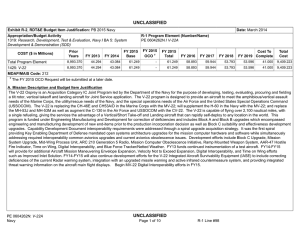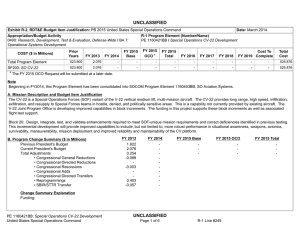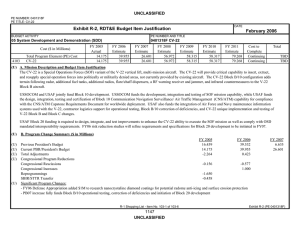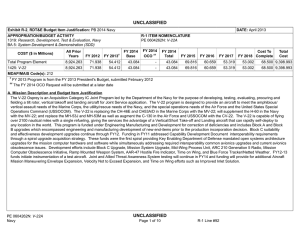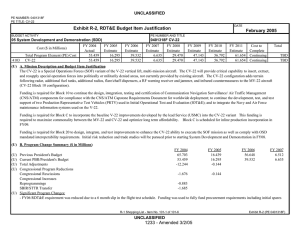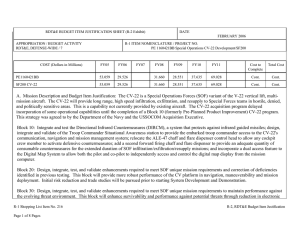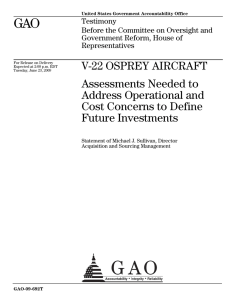V-22 Osprey Joint Advanced Vertical Lift Aircraft
advertisement
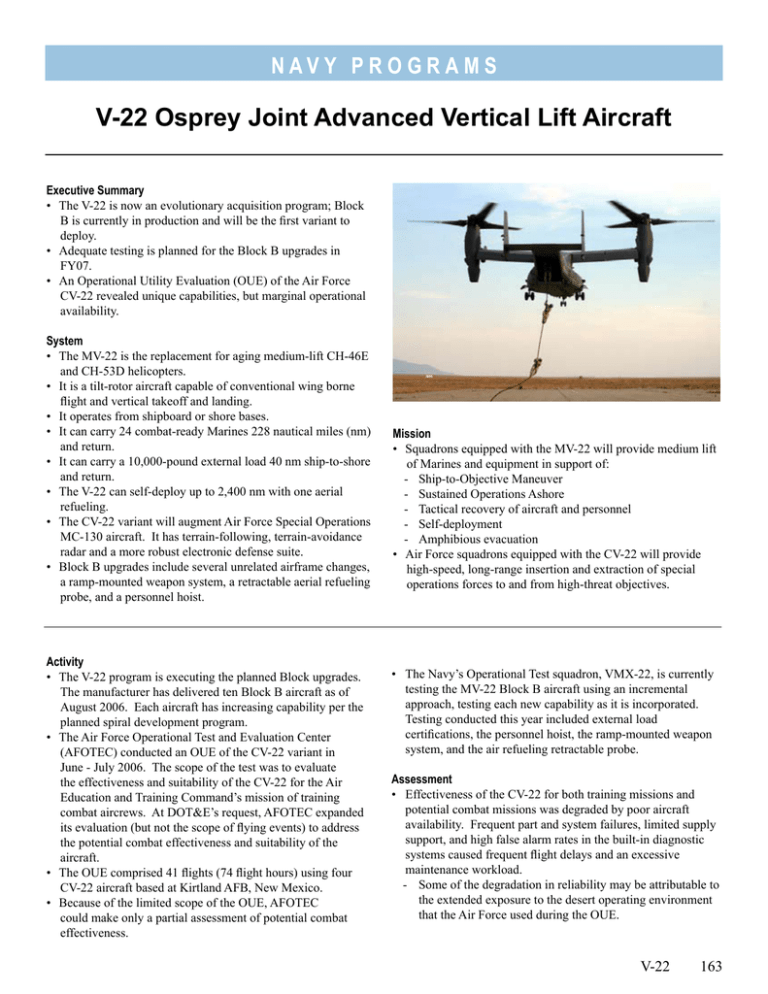
Navy P RO G R A M S V-22 Osprey Joint Advanced Vertical Lift Aircraft Executive Summary • The V-22 is now an evolutionary acquisition program; Block B is currently in production and will be the first variant to deploy. • Adequate testing is planned for the Block B upgrades in FY07. • An Operational Utility Evaluation (OUE) of the Air Force CV-22 revealed unique capabilities, but marginal operational availability. System • The MV-22 is the replacement for aging medium-lift CH-46E and CH-53D helicopters. • It is a tilt-rotor aircraft capable of conventional wing borne flight and vertical takeoff and landing. • It operates from shipboard or shore bases. • It can carry 24 combat-ready Marines 228 nautical miles (nm) and return. • It can carry a 10,000-pound external load 40 nm ship-to-shore and return. • The V-22 can self-deploy up to 2,400 nm with one aerial refueling. • The CV-22 variant will augment Air Force Special Operations MC-130 aircraft. It has terrain-following, terrain-avoidance radar and a more robust electronic defense suite. • Block B upgrades include several unrelated airframe changes, a ramp-mounted weapon system, a retractable aerial refueling probe, and a personnel hoist. Activity • The V-22 program is executing the planned Block upgrades. The manufacturer has delivered ten Block B aircraft as of August 2006. Each aircraft has increasing capability per the planned spiral development program. • The Air Force Operational Test and Evaluation Center (AFOTEC) conducted an OUE of the CV-22 variant in June - July 2006. The scope of the test was to evaluate the effectiveness and suitability of the CV-22 for the Air Education and Training Command’s mission of training combat aircrews. At DOT&E’s request, AFOTEC expanded its evaluation (but not the scope of flying events) to address the potential combat effectiveness and suitability of the aircraft. • The OUE comprised 41 flights (74 flight hours) using four CV-22 aircraft based at Kirtland AFB, New Mexico. • Because of the limited scope of the OUE, AFOTEC could make only a partial assessment of potential combat effectiveness. Mission • Squadrons equipped with the MV-22 will provide medium lift of Marines and equipment in support of: - Ship-to-Objective Maneuver - Sustained Operations Ashore - Tactical recovery of aircraft and personnel - Self-deployment - Amphibious evacuation • Air Force squadrons equipped with the CV-22 will provide high-speed, long-range insertion and extraction of special operations forces to and from high-threat objectives. • The Navy’s Operational Test squadron, VMX-22, is currently testing the MV-22 Block B aircraft using an incremental approach, testing each new capability as it is incorporated. Testing conducted this year included external load certifications, the personnel hoist, the ramp-mounted weapon system, and the air refueling retractable probe. Assessment • Effectiveness of the CV-22 for both training missions and potential combat missions was degraded by poor aircraft availability. Frequent part and system failures, limited supply support, and high false alarm rates in the built-in diagnostic systems caused frequent flight delays and an excessive maintenance workload. - Some of the degradation in reliability may be attributable to the extended exposure to the desert operating environment that the Air Force used during the OUE. V-22 163 Navy P RO G R A M S • Combat effectiveness is expected to be enhanced by the speed and range capabilities of the V-22, a well-designed cockpit, and an effective multi-mode radar that enables low-level flight at night and in poor visibility. • Design weaknesses were identified in radio navigation systems, defensive electronic countermeasures, the aircraft fuel system, and the cabin cooling system. • The inherent speed and range of the V-22 aircraft enhances the ability to self-deploy the CV-22 on short notice. Limitations associated with airframe and navigation systems degraded this capability, however. • Emerging results indicate the MV-22 Block B hoist, aerial refueling probe, and ramp-mounted weapon system are functional in the current configuration. Operational testing conducted in FY07 will assess operational effectiveness and suitability of these subsystems prior to the first MV-22 deployment. • The MV-22 Block B fuel system has exhibited poor performance, similar to that observed with the CV-22. Recommendations • Status of Previous Recommendations. The program has taken effective action on five of the seven recommendations 164 V-22 in DOT&E’s 2005 report on Operational and Live Fire Test and Evaluation. The following two recommendations remain valid: - Determine the effectiveness of the engine bay fire extinguishing system against actual threat induced fires. - Devise/improve cabin wall battle damage repair methods and procedures. Damage to this wall by threat impact can make the aircraft unavailable for an extensive period. • FY06 Recommendations. The program should: 1. Correct the aircraft deficiencies noted in the CV-22 OUE report prior to IOT&E in FY08. 2. Extend or modify the planned training before IOT&E to allow for degraded aircraft availability. 3. Execute the planned defensive electronic countermeasure upgrade and testing. 4. Continue to monitor operational suitability of the Block B aircraft to determine discrepancy between CV-22 performance during their OUE and the performance reported for the MV-22 operational evaluation last year.
